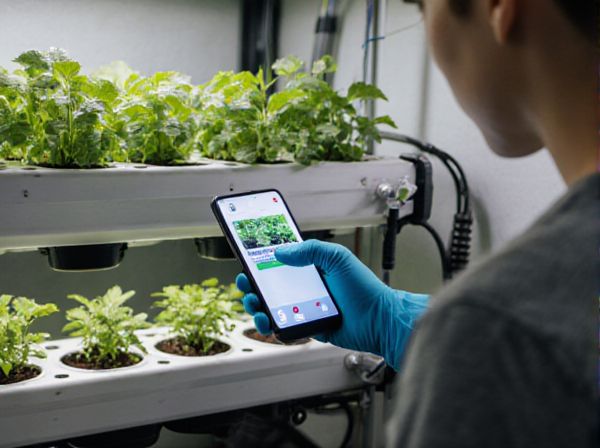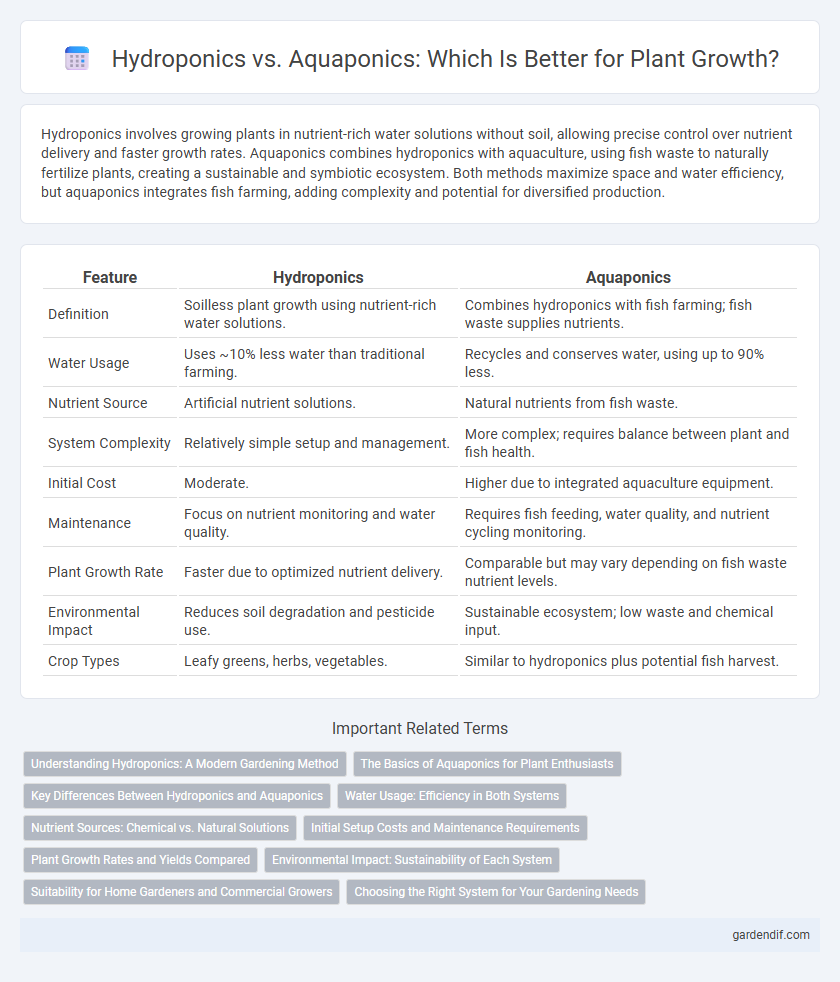
Hydroponics vs Aquaponics Illustration
Hydroponics involves growing plants in nutrient-rich water solutions without soil, allowing precise control over nutrient delivery and faster growth rates. Aquaponics combines hydroponics with aquaculture, using fish waste to naturally fertilize plants, creating a sustainable and symbiotic ecosystem. Both methods maximize space and water efficiency, but aquaponics integrates fish farming, adding complexity and potential for diversified production.
Table of Comparison
| Feature | Hydroponics | Aquaponics |
|---|---|---|
| Definition | Soilless plant growth using nutrient-rich water solutions. | Combines hydroponics with fish farming; fish waste supplies nutrients. |
| Water Usage | Uses ~10% less water than traditional farming. | Recycles and conserves water, using up to 90% less. |
| Nutrient Source | Artificial nutrient solutions. | Natural nutrients from fish waste. |
| System Complexity | Relatively simple setup and management. | More complex; requires balance between plant and fish health. |
| Initial Cost | Moderate. | Higher due to integrated aquaculture equipment. |
| Maintenance | Focus on nutrient monitoring and water quality. | Requires fish feeding, water quality, and nutrient cycling monitoring. |
| Plant Growth Rate | Faster due to optimized nutrient delivery. | Comparable but may vary depending on fish waste nutrient levels. |
| Environmental Impact | Reduces soil degradation and pesticide use. | Sustainable ecosystem; low waste and chemical input. |
| Crop Types | Leafy greens, herbs, vegetables. | Similar to hydroponics plus potential fish harvest. |
Understanding Hydroponics: A Modern Gardening Method
Hydroponics is a soil-free gardening technique that uses nutrient-rich water solutions to grow plants, promoting faster growth and higher yields compared to traditional soil-based methods. This method allows precise control over nutrient delivery, pH levels, and environmental conditions, optimizing plant health and reducing water usage by up to 90%. Common hydroponic systems include nutrient film technique (NFT), deep water culture (DWC), and aeroponics, each designed to maximize root oxygenation and nutrient absorption for efficient plant development.
The Basics of Aquaponics for Plant Enthusiasts
Aquaponics combines hydroponics with aquaculture, creating a symbiotic environment where fish waste provides essential nutrients for plants, eliminating the need for chemical fertilizers. This sustainable system balances plant growth with aquatic life, promoting efficient water usage and nutrient recycling. Plant enthusiasts benefit from aquaponics by cultivating healthier plants through natural nutrient cycles and reduced environmental impact.
Key Differences Between Hydroponics and Aquaponics
Hydroponics relies on nutrient-rich water solutions to grow plants without soil, whereas aquaponics integrates fish farming with plant cultivation by using fish waste to provide nutrients. Hydroponic systems require synthetic or organic nutrient inputs, while aquaponics depends on the biological filtration of fish waste for sustainable nutrient cycling. The water management in aquaponics is more complex due to the balance needed between aquatic life and plants, contrasting with the more controlled nutrient delivery in hydroponic setups.
Water Usage: Efficiency in Both Systems
Hydroponics uses up to 90% less water than traditional soil gardening by recirculating nutrient-rich water directly to plant roots, minimizing waste through closed-loop systems. Aquaponics combines fish farming with hydroponics, where fish waste supplies nutrients to plants, and water is continuously recycled, achieving remarkable water conservation by linking two ecosystems. Both systems dramatically reduce water consumption compared to conventional agriculture, making them highly efficient for sustainable plant cultivation.
Nutrient Sources: Chemical vs. Natural Solutions
Hydroponics relies on chemical nutrient solutions composed of precise mineral salts to feed plants directly, ensuring controlled and consistent nutrient availability. Aquaponics integrates natural nutrient sources through fish waste, where beneficial bacteria convert ammonia into nitrates, providing an organic fertilizer that supports plant growth. This biological nutrient cycling in aquaponics creates a sustainable ecosystem, contrasting with hydroponics' dependence on synthetic nutrient formulations.
Initial Setup Costs and Maintenance Requirements
Hydroponics systems generally have lower initial setup costs, requiring only water, nutrients, and growing mediums, whereas aquaponics setups involve additional expenses for fish tanks, pumps, and biofilters. Maintenance in hydroponics revolves around monitoring nutrient concentrations and preventing disease, while aquaponics demands balancing fish health, water quality, and nutrient cycling, which can be more complex and time-consuming. Both systems require regular equipment checks, but aquaponics involves higher operational intricacies due to the integration of aquatic life management.
Plant Growth Rates and Yields Compared
Hydroponics systems typically achieve faster plant growth rates due to the direct availability of nutrients through water solutions, allowing for precise control over nutrient levels and pH. Aquaponics integrates fish waste as a natural fertilizer, which can enhance plant yields by providing a steady nutrient supply but may result in slower growth rates compared to hydroponics due to nutrient variability. Studies show hydroponic crops can grow up to 25-50% faster, while aquaponic systems promote sustainable yields with added benefits of fish production and ecosystem balance.
Environmental Impact: Sustainability of Each System
Hydroponics uses nutrient-rich water to grow plants, minimizing soil degradation and reducing water usage by up to 90% compared to traditional farming, making it highly sustainable in water-scarce regions. Aquaponics combines hydroponics with aquaculture, creating a symbiotic ecosystem where fish waste provides organic nutrients for plants, further reducing chemical fertilizer use and promoting biodiversity. Both systems lower greenhouse gas emissions by decreasing the need for synthetic inputs and land conversion, with aquaponics offering added benefits of sustainable fish production.
Suitability for Home Gardeners and Commercial Growers
Hydroponics offers precise control over nutrient delivery, making it ideal for home gardeners seeking space-efficient, soil-free cultivation with faster plant growth. Aquaponics integrates fish farming with plant cultivation, providing a sustainable ecosystem favored by commercial growers for nutrient recycling and reduced water usage. Both systems suit different scales and goals; hydroponics excels in smaller, controlled environments, while aquaponics supports larger operations with combined agriculture and aquaculture benefits.
Choosing the Right System for Your Gardening Needs
Hydroponics offers a soil-free method that delivers nutrients directly to plant roots using a water-based solution, making it ideal for growers seeking precise control over nutrient levels and faster growth rates. Aquaponics combines fish farming with plant cultivation, creating a symbiotic environment where fish waste fertilizes plants, perfect for those interested in sustainable systems and integrating aquaculture. Selecting between hydroponics and aquaponics depends on space availability, desired crop types, resource investment, and maintenance commitment to optimize yield and sustainability.
Hydroponics vs Aquaponics Infographic

 gardendif.com
gardendif.com